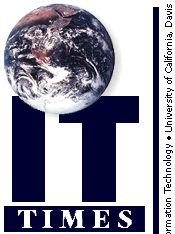
The Rural Learning Network: A Virtual Faculty Room
by Rick Pomeroy, Division of EducationImagine that you are a fifth grade teacher in a small school district in the Sierra Nevada foothills or a rural Central Valley agricultural town. Your school is the center of the community; most students will attend their entire elementary years on your campus. How do you know how they are doing? Is their academic development on a par with that of students in larger districts? Are their social skills developing in a way that will allow them to integrate into the larger suburban high school for grades 9-12? Or, possibly you are a student teacher, seeking exposure to a wide range of curriculum ideas or management strategies to use in your classroom. Who do you talk to for answers? Your colleagues and fellow student teachers are helpful but their perspectives are limited to the same situations that you are experiencing.
Attempting to address these concerns, Assistant Professor Maureen McMahon and I are engaged in collaborative work with Waggoner Elementary School and Winters Middle School in Winters, Cache Creek High School in Yolo, Camptonville Elementary School in Camptonville, and Yuba Feather School in Challenge to study the creation, implementation, and utilization of a Rural Learning Network (RLN). Envisioned as a virtual faculty room, the RLN offers student teachers and rural teachers email communications, work group links, and curriculum development opportunities. These opportunities might otherwise be impossible given the geographical distances and boundaries that exist within this extended community.
Emulating a faculty room conversation, the RLN strives to bring together teachers and student teachers who share many of the same goals, questions, and concerns. Participants often post questions or ideas to the RLN listserver and receive responses from throughout the RLN community. These conversations have evolved from simple social interactions to extended conversations on the use of technology in classrooms. Teachers are sharing student work between sites, developing collaborative scientific studies, and exchanging curriculum ideas. Student teachers who began the project during the 1996-97 school year are now participating as they enter their first years of teaching.
Early research on the use of the RLN has indicated that faculty and student teacher reaction to the virtual faculty room analogy is quite accurate. Electronic conversations appeared to be following patterns typical to faculty rooms in schools across the state. Messages posted to the RLN were reviewed for content and coded as either social, administrative, or informational. During the first several months, the content of the messages was largely social or administrative in nature. As participants became familiar with the RLN and the benefits it could provide, the majority of the messages became informational. Teachers and student teachers used the RLN as a source for lesson and resource ideas as well as a way to offer suggestions to those seeking information about science content.
The Rural Learning Network has created a community of teachers in small schools whose unique teaching situations have, until now, existed in semi-isolation.
For more information:
- Rural Learning Community Network: http://education.ucdavis.edu/K-12/TRLN
Rick Pomeroy is Supervisor of Science Teacher Education, Division of Education.